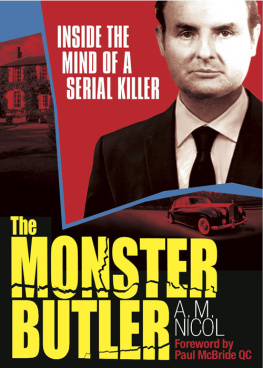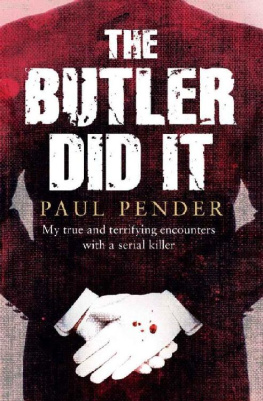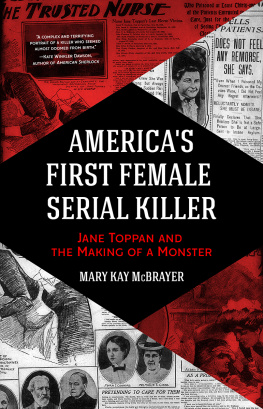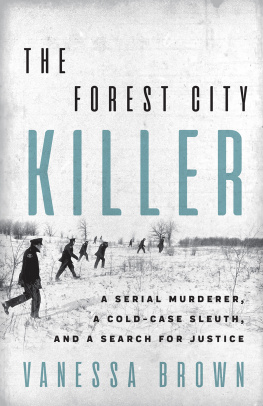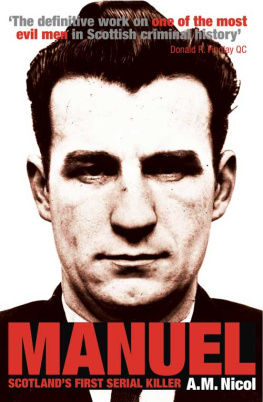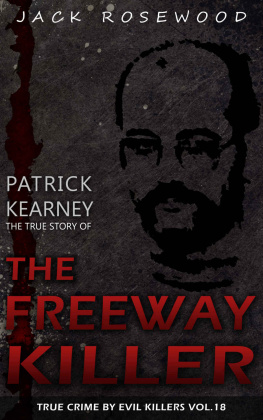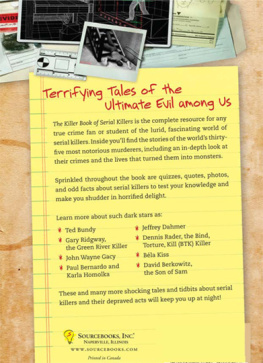Allan Nicol - The Monster Butler: Serial Killer
Here you can read online Allan Nicol - The Monster Butler: Serial Killer full text of the book (entire story) in english for free. Download pdf and epub, get meaning, cover and reviews about this ebook. year: 2011, publisher: Black & White Publishing, genre: Detective and thriller. Description of the work, (preface) as well as reviews are available. Best literature library LitArk.com created for fans of good reading and offers a wide selection of genres:
Romance novel
Science fiction
Adventure
Detective
Science
History
Home and family
Prose
Art
Politics
Computer
Non-fiction
Religion
Business
Children
Humor
Choose a favorite category and find really read worthwhile books. Enjoy immersion in the world of imagination, feel the emotions of the characters or learn something new for yourself, make an fascinating discovery.
- Book:The Monster Butler: Serial Killer
- Author:
- Publisher:Black & White Publishing
- Genre:
- Year:2011
- Rating:5 / 5
- Favourites:Add to favourites
- Your mark:
- 100
- 1
- 2
- 3
- 4
- 5
The Monster Butler: Serial Killer: summary, description and annotation
We offer to read an annotation, description, summary or preface (depends on what the author of the book "The Monster Butler: Serial Killer" wrote himself). If you haven't found the necessary information about the book — write in the comments, we will try to find it.
The Monster Butler: Serial Killer — read online for free the complete book (whole text) full work
Below is the text of the book, divided by pages. System saving the place of the last page read, allows you to conveniently read the book "The Monster Butler: Serial Killer" online for free, without having to search again every time where you left off. Put a bookmark, and you can go to the page where you finished reading at any time.
Font size:
Interval:
Bookmark:
HOW I DID IT BY THE BUTLER
THE REAL ROY FONTAINE
THE MAKING OF A MONSTER
I am grateful to Mirian and Moray; to Paul for providing the Foreword; to the staff at the National Archives, Edinburgh, and the Mitchell Library, Glasgow, and to all at Black & White Publishing.
Over the years, Scotland has produced serial killers from Manuel to Tobin and, gruesome as their crimes may have been, they have always caught the imagination of a public hungry for information as to how ordinary people from seemingly normal backgrounds can go on to commit the vilest of crimes.
A. M. Nicol, a very talented advocate, has now turned his forensic skills to studying a man from humble beginnings who was born in Partick in 1924, originally as Archibald Hall, but who later became known as Roy Fontaine, the serial killer who murdered not only his own brother but four other people apparently for gain, glamour and possibly pleasure.
In this detailed investigation, Nicol charts how Archibald Hall briefly became a butler to some of the finest gentlemen in society and studied in intricate detail the etiquette of polite society and their accents and protocol, all with a view to ultimately lining his own pockets. Hall was undoubtedly a formidable personality with the ability to lie, cheat and steal.
However, the real question in this fascinating insight into a deranged individual is how he became an uncaring serial killer. With impeccable research both north and south of the border, Nicol strips away the layers of this complicated man to reveal the dedication, obsession and greed that drove him to become the notorious individual we now know him to be.
The Monster Butler is a must read for anyone interested in human nature, the psychology of killers, the legal process and the parts of this countrys history that many people would rather forget. This book deals with the age-old question of whether someone is merely fulfilling a predetermined destiny set in the stars, or whether a combination of circumstances or indeed the nature of evil itself were all factors that gave rise to this most unusual, refined, clever, enigmatic, flawed but ultimately heartless murderer.
This is a book not only of history and of human interest, but its message is also relevant to the times in which we currently live, as we are continually faced with the inexplicable cruelty of the criminal mind.
Impeccable research, clear narrative and logical analysis are the hallmarks of this excellent work but most of all it is a simply stunning read.
In 1919, the fifteen victorious allies of the Great War struck their own similar versions of a bronze medal called the Victory Medal. Any curiosity from the generations to come as to what had been at stake during the conflict can be easily answered: the reverse of the British version of the medal declares it had been The Great War For Civilisation 19141919.
Civilisation, no less, had been at stake and the sacrifice of millions ensured that the fragile blossoming of human development, as seen through western eyes at the time, continued on its random way. But how is civilisation judged?
In 1924, in Chicago, Illinois, the civilised world was forced to come to terms with unexplained barbarity in its own ranks when it emerged that two highly intelligent teenagers from wealthy backgrounds, Leopold and Loeb, had planned and carried out the murder of fourteen-year-old Bobby Franks for only one possible reason fun.
Attempting to stop his clients executions, the famous lawyer Clarence Darrow addressed the court for twelve hours, and the judge decided not to impose death sentences, due in part to the ages of the killers. The judge also said:
Life imprisonment, at the moment, strikes the public imagination as forcibly as would death by hanging, but to the offenders, particularly of the type they are, the prolonged suffering of years of confinement may well be the severest form of retribution and expiation.
A civilised response to a barbaric act? To this day, the debate about executing murderers, or at least some of the more cold-blooded of them, continues.
That same year, a serial killer who was at least as ruthless as the two Chicago teenagers was born in Scotland.
After twenty-two-year-old Mary McMillan and twenty-eight-year-old Archibald Thomson Hall were married, their son was born in a flat in what was then called MacLean Street in the Partick area of Glasgow on 17 July 1924.
The boy was called Archibald Thomson Hall after his father and grandfather but would become better known as serial killer Roy Fontaine The Monster Butler. Fontaine must surely be one of the strangest characters to emerge in recent British criminal history, an area not lacking in odd individuals.
Apart from murdering five people, including Donald, his younger brother by nearly seventeen years, and spending most of his life in prison, where he died in 2002, Fontaine stands out for other reasons he published his life story A Perfect Gentleman in 1999, later published as To Kill and Kill Again after his death; even Moors Murderer Myra Hindley failed to get her autobiography published. Moreover, there cannot be many who have been given life sentences for murder in both Scotland and England in the same year.
Whilst some offenders prefer to hide from the glare of publicity, Fontaine positively basked in it. He was far more encouraged than embarrassed by the media reaction to his murder convictions in 1978 and quickly tried to start a bidding war for his story. He courted as many journalists as he could to interest them in his own account of events and even encouraged relatives to cash in by telling what it was like to know him.
That said, it would have been difficult for Fontaine in particular not to have revelled in the sort of stuff being written in crime magazines more in hope of sales than anything else such as:
He was a connoisseur of fine wines, an expert in antiques and a consummate actor. After spending most of his life in prison for jewellery thefts, he planned one more haul that would set him up in comfort for his old age. But his willingness to kill destroyed him.
From then on, he crafted the cultured gentleman jewel thief image he desired.
When serving out his final jail sentence, he also demanded elective state euthanasia for prisoners serving natural life as he was whilst at the same time keeping an anxious eye on the possibility of a return to capital punishment. For Fontaine, the worst thing was not to be noticed.
But why would a serial killer with so much to hide want people to know so much about him? What does it say about him, except that he clearly sought sympathy?
Certainly, if the cover of A Perfect Gentleman is to be believed, Fontaine was a rich rogue driven to murder in extreme circumstances. The cover blurb states:
Roy Archibald Hall was born into the poverty of pre-war Glasgow in 1924. As an exceptionally successful con-man and jewel thief, he lived the luxurious life of a high-class criminal easy money punctuated by occasional prison time but at the age of fifty-four, the smooth talking butler murdered a homosexual who tried to blackmail him. Another four people, including his brother, would die at his hands.
Even allowing for exaggeration, occasional prison time hardly encapsulates the actual time the exceptionally successful conman and jewel thief spent safely locked away from potential victims. He was deemed to be insane three times and was sentenced, in total, to over seventy years in prison before he received the natural life term in November 1978, aged fifty-four.
Yet, he is perhaps not as notorious as he should be given the outrages he committed because his more serious crimes occurred between 1977 and 1978. At that time, British society was coming to terms with the string of murders attributed to the Yorkshire Ripper, later found out to have been committed by a man named Peter Sutcliffe, and when Fontaine was finally arrested in East Lothian in 1978, it was only a few months after the brutal rape and murder of two young girls from Edinburgh, later known as the Worlds End murders, so his sudden flurry of murderous activity in both England and Scotland attracted less interest than might otherwise have been expected.
Font size:
Interval:
Bookmark:
Similar books «The Monster Butler: Serial Killer»
Look at similar books to The Monster Butler: Serial Killer. We have selected literature similar in name and meaning in the hope of providing readers with more options to find new, interesting, not yet read works.
Discussion, reviews of the book The Monster Butler: Serial Killer and just readers' own opinions. Leave your comments, write what you think about the work, its meaning or the main characters. Specify what exactly you liked and what you didn't like, and why you think so.

